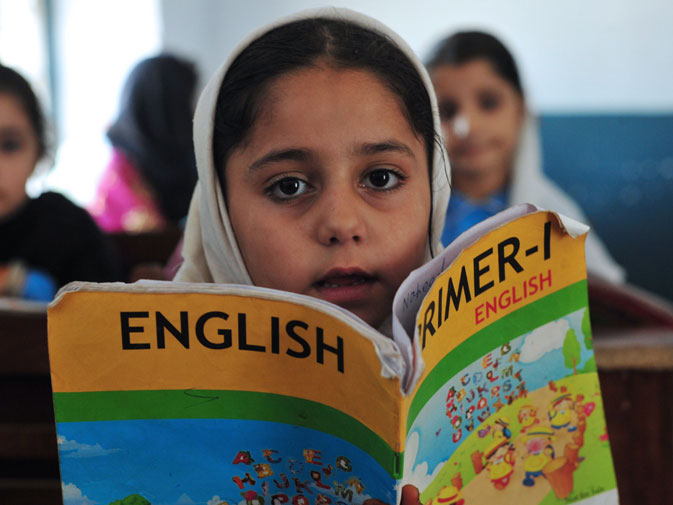
LAHORE:
Having claimed enrolment of as many as 3.6 million children during the Jahalat Say Azadi drive, the School Education Department (SED) now says it is likely to achieve 100 per cent enrolment of students in the 5 to 9 age bracket by 2015.
A recent independent survey, however, has indicated that almost 18 per cent of children in the 5 to 9 years age bracket are still out of school.
SED Secretary Abdul Jabbar Shaheen told The Express Tribune that the chief minster’s education drive had not only exceeded expectations but had also encouraged the government to aim for 100 per cent enrolment by 2015. The government has crossed its official target for enrolment in 2013- 2.8 million children, he said. Shaheen said the drive had not only focused on enrolment but also the retention of students. A monitoring mechanism has been introduced to improve the quality of education, he said. He said 14 indicators of quality schooling and education had been identified including teachers’ attendance, students’ attendance, teacher training, availability and functioning of previously missing facilities and supervision by district administration teams. Shaheen said all indicators showed 90 per cent or better performance in 2013.
SED’s official data states that there are more than 57,000 [primary, middle and high schools] schools in the province. There are nearly 2.1 million boy students in primary schools and 1.7 million girl students. There are 115,000 boy students and 118,000 girl students enrolled in middle-primary schools.
The Annual Status of Education Report 2013 for the Punjab indicates that while the percentage of out-of-school children in the 6 to 16 age bracket is 16 per cent - exactly where it was last year – the percentage of out-of-school children aged 5 years and below is 18.2 per cent.
The ASER’s statistics indicate stagnation in the enrolment of out-of-school children, but SED Deputy Secretary Qaiser Rasheed contests these findings. SED’s surveys indicate that there are 21 million children enrolled in various educational systems in the province. Of these, 52 per cent of them, (11 million), are enrolled in government schools and almost 38 per cent (8 million) in private and government-private schools. The figures suggest that 9.52 per cent of the 21 million (almost 2 million) are enrolled in other educational institutions.
Apart from these 21 million children, the SED says it will now focus on enrolling out-of-school children in the 5 to 9 age bracket, identified in the 2013 Nielsen Survey.
Rasheed said the Nielsen Survey had identified almost 2.1 million children in the 5 to 9 age bracket that were still out of school and had not been mentioned in any of the official surveys. He said they had managed to enrol 33 per cent of these children in 2013. Almost 66.6 per cent of the children in the years 5 to 9 age bracket, mentioned in the Nielson Survey, are still out-of-school. The SED will now focus on enrolling the remaining out-of-school children over the next three years, said Rasheed.
Rasheed says updated official figures are not available and the government largely relies on projected figures or surveys. Unofficial surveys are helpful in analysing the situation but are not entirely accurate, he says.
The government is focusing on achieving 100 per cent universal primary school enrolment and figures addressing the target age bracket would be more helpful, said Rasheed. “We are targeting children in the 5 to 9 age bracket because this is when children can make up for lost time even if they weren’t enrolled at the age of 5,” he said.
A different strategy needs to be devised for children over the age of 10 years who have never been enrolled, he said. “These children are usually enrolled in non-formal and vocational schools,” he said.
The ASER 2013 survey mentions that 8.3 per cent children in the 6 to 10 age bracket have never been enrolled in schools. Another 2 per cent of children in the same age cohort have dropped out of school. This indicates that almost 10 per cent of the children in the 6 to 10 age bracket are out of school in the province apart from the 18 per cent 5 year-olds who are out of school. The SED however maintains that the figures do not suggest a bleak prospect for children in the province. “Our target is 100 per cent universal primary education by 2015 and our target age bracket will be children aged 5 to 9,” said Rasheed.
Published in The Express Tribune, February 19th, 2014.
COMMENTS (7)
Comments are moderated and generally will be posted if they are on-topic and not abusive.
For more information, please see our Comments FAQ


























































And then people question why there is peace in Punjab only?. Merit prevails here. Bureaucracy and law and order institutions are a big joke in places like interior sindh, where recent survey have indicated education indicators to be worse than even FATA . You can get your ma degree there for few rupees . Publish these comments et if you have guts.
primary education must be free
@ria if you're PTI supporter then it's okay if not then please think wisely and acknowledge if things are getting settled
Setting the deadlines only won't achieve anything. The sooner we walk the talk, the better.
Enrollment of 100% of kids in Punjab in schools means that you won't find any child beggar on the streets, you won't find any under-age labor either, nor at the road-side vendors where a horde of kids do business, or assist their elders, for a living. Are you really aiming that big, PML-N? What are your credentials?
lol.... good joke...looks like fooling public is the only thing pakistani leaders know...hehehe
Sound too good to be true ..
We have a history to judge from .